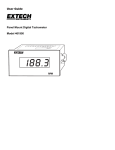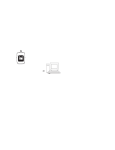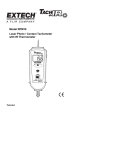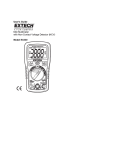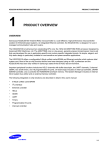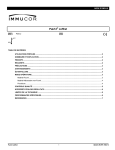Download User's Guide Power Analyzer Model 380801
Transcript
User's Guide Power Analyzer Model 380801 Power Analyzer Datalogger Model 380803 Introduction Congratulations on your purchase of the Extech 380801 or 380803 Power Analyzer Datalogger. This device offers the following features: • Convenient front panel plug-in and testing • Four displays for Watts, PF/VA, V/KHz, Amperes • True power, true RMS for AC Voltage (V) and Current (A) • Datalogger stores over 1000 readings (Model 380803) • Auto Range for Watts and Volts • RS-232 PC Interface • WindowsTM Application Software Careful use of this meter will provide years of reliable service. 1 380801-380803 V7.0 8/06 Warranty EXTECH INSTRUMENTS CORPORATION warrants this instrument to be free of defects in parts and workmanship for one year from date of shipment (a six month limited warranty applies on sensors and cables). If it should become necessary to return the instrument for service during or beyond the warranty period, contact the Customer Service Department at (781) 890-7440 ext. 210 for authorization or visit our website at www.extech.com (click on ‘Contact Extech’ and go to ‘Service Department’ to request an RA number). A Return Authorization (RA) number must be issued before any product is returned to Extech. The sender is responsible for shipping charges, freight, insurance and proper packaging to prevent damage in transit. This warranty does not apply to defects resulting from action of the user such as misuse, improper wiring, operation outside of specification, improper maintenance or repair, or unauthorized modification. Extech specifically disclaims any implied warranties or merchantability or fitness for a specific purpose and will not be liable for any direct, indirect, incidental or consequential damages. Extech's total liability is limited to repair or replacement of the product. The warranty set forth above is inclusive and no other warranty, whether written or oral, is expressed or implied. Specifications WATT (Auto Range, AC+DC, Crest Factor < 5) Range Resolution Accuracy Input 200W 0.1W ±(0.9% reading + 5digts) (50/60Hz) 0-300V, 0-20A, 2000W 1W ±(5% reading + 9digts) (40 to 400Hz) PF=0.5 to 1 VOLTAGE (True RMS, Auto Range, AC+DC, Crest Factor < 5) Range Resolution 200V 0.1V 750V 1V Accuracy Overload Protection ±(0.5% reading + 5digts) (40 to 400Hz) 1000VDC/750VAC CURRENT (True RMS, AC+DC, Crest Factor < 5) Range Resolution 2 0.001A 20 0.01A Accuracy (40 to 400Hz) Overload Protection ±(0.5% reading + 5digts) 20A, fused PF (Direct Calculation from W, V, A): PF = Watt / (V * A) FREQUENCY (Sensitivity 5V) Range 40Hz to 20kHz Memory Size (380803) Resolution Accuracy 1Hz-10Hz ±(0.5% of rdg ±2digts 1012 x 4 readings (non-volatile) Memory Life (380803) 100,000 memory writes Display 2000 count LCD displays Over Range Indication ‘OL’ displayed on LCD Sampling Rate 2.5 times per second Power Source Eight 1.5V ‘AA’ batteries or AC adaptor Power Consumption 22 mA approx. Operating conditions 32 to 122 F (0 to 40 C); Less than 80% Dimension 13.9"(L) x 11.8"(W) x 3.9" (H) Weight 3.6 lbs (1.637 Kg) approx. o o 352(L) x 300(W) x 100(H)mm 2 380801-380803 V7.0 8/06 3 380801-380803 V7.0 8/06 Basic Operation Warning: If a power source of 220V is connected to the input voltage terminal/receptacle, do not connect a110V device to the output load terminal/receptacle. Using Receptacles 1. Plug one end of the power cord into the input receptacle and plug the other end into the wall outlet. 2. Plug the device to be tested into the output load receptacle. The display will show the W, PF, V, and A for the device under test. Note 2: W= VA, 1KW = 1KVA = 1000W = 1000VA, when PF = 1. Warning: The input receptacle and terminal are connected in parallel (as are the outputs). To avoid electrical shock, do not touch any metal part of the receptacle or terminal. Using Terminals 1. Plug one end of the power leads into the input voltage terminal (left) and connect the other end of the test leads to the power source. 2. Plug the device power leads into the output load terminals. W, PF, V, and A will display for the device under test. Note 2: W=VA, 1KW = 1KVA = 1000W = 1000VA, when PF =1 at DC Warning: The input and output receptacle and terminal are connected in parallel Do not touch any metal part of the receptacle or terminal to avoid electrical shock. 4 380801-380803 V7.0 8/06 Using a Current Transformer Warning: Only personnel well trained in the principles of Current Transformers (CT) should attempt this test connection. When connecting a CT, follow the wiring diagrams and instructions below. 1 2W Power Line K K I L Motor 1. Connect the CT’s k terminal (entering the CT) to the power line that passes through the CT, and connect this k terminal to the input voltage black terminal (ground). 2. Connect the other power line to the input voltage red terminal. 3. Connect the CT’s l terminal (leaving the CT) to the output load black terminal (ground). 4. The Watt reading and Amp reading should be multiplied by the CT ratio. The V and PF readings do not need to be multiplied by the CT ratio. Warning: The input receptacles and terminals are connected in parallel (as are the outputs). Do not touch any metal part of the receptacle or terminal. 5 380801-380803 V7.0 8/06 PC Interface for Data Acquisition & Datalogging Features Data Acquisition Models 380801 and 380803 can be connected to a PC where readings can be logged in realtime as they are taken. Transferred reading data can be viewed, plotted, statistically analyzed, printed, saved, and imported in spreadsheet, database, word processing, and other software programs. Instructions for Data Acquisition are included in the separate Data Acquisition and Datalogging Manual on the software disc. Datalogging (Model 380803 only) The Model 380803 has built-in memory where over one thousand readings can be stored for later transfer to PC. Once transferred, data can be viewed, plotted, statistically analyzed, printed, saved as a text file, and imported in spreadsheet, database, word processing, and other software programs Instructions for Datalogging are included in the separate Data Acquisition and Datalogging Manual. 6 380801-380803 V7.0 8/06 Replacement of Batteries and 20A Fuse Battery Replacement When the low battery symbol is displayed on any of the LCDs, replace the eight (8) 1.5V ‘AA’ batteries. 1. Turn off the power analyzer. 2. Open the battery compartment by using a screw driver (see diagram). 3. Replace the batteries. 4. Replace the battery compartment. 20A Fuse Replacement To replace the 20A fuse, remove the fuse cover as indicated in item (5) in the Meter Description section earlier in this manual and replace the fuse if necessary. Warning: Do not replace the blown fuse with a fuse rating greater than 20A. Measurement of 3-Phase 3-Wire Power Using One Power Analyzer Measure WRS first (RST phases must be correctly identified) 1. Connect the R-phase of the power source to the black terminal of the input voltage 2. Connect the S-phase of the power source to the red terminal of the input voltage 3. Plug the R-phase of the device to be tested to the black terminal of the output load. Do not short the Rphase of the device to be tested to the R-phase of the input power source. 4. Record the reading of WRS displayed on the ‘W’ LCD. Measure WTS secondly (RST phases must 7 380801-380803 V7.0 8/06 Using Two Power Analyzers Measure WRS and WTS (RST phases must be correctly identified) 1. Connect the R-phase of the power source to the black terminal of the input voltage of power analyzer 1. 2. Connect the S-phase of the power source to the red terminal of the input voltage of power analyzer 1. 3. Plug the R-phase of the device to be tested to the black terminal of the output load of power analyzer 1. Do not short the R-phase of the load to the R-phase of the input power source. 4. 5. Record the reading of WRS displayed on the ‘W’ LCD of power analyzer 1. Connect the T-phase of the power source to the black terminal of the input voltage of power analyzer 2. 6. Connect the S-phase of the power source to the red terminal of the input voltage of power analyzer 2. 7. Plug the T-phase of the device to be tested to the black terminal of the output load. Do not short the T-phase of the device to be tested to the T-phase of the input power source. 8. Record the reading of WTS displayed on the Watt LCD of power analyzer 2. 8 380801-380803 V7.0 8/06 Using Current Transformers (CT) with 2 Power Analyzers Measure WRS and WTS (RST phases must be correctly identified) 1. Connect the R-Phase to the black terminal of the input voltage of power analyzer 1. 2. Connect the S-phase to the red terminal of the input voltage of power analyzer 1. 3. Connect the k terminal of CT1 to the R-phase. 4. Connect the l terminal of CT1 to the black terminal of the output load of power analyzer 1. 5. The Watt reading of the power analyzer 1 is WRS 6. Connect the T-phase to the black terminal of the input voltage of power analyzer 2. 7. Connect the S-phase to the red terminal of the input voltage of power analyzer 2. 8. Connect the k terminal of CT2 to the R-phase. 9. Connect the l terminal of CT2 with the black terminal of the output load of power analyzer 1. 10. The Watt reading of the power analyzer 2 is WTS 9 380801-380803 V7.0 8/06 Glossary of Terms W PF V A Phase angle True Watt Power Factor True RMS Voltage True RMS Ampere Time difference between V and A calculated by cos-1 (Power Factor) VA VAR IR Req IL XL Leq CAP CR LF EPS EPE W 3φ Apparent Power (V * A) 2 2 Reactive Power (SQRT [VA – W ]) Equivalent current (through equivalent resistance) Equivalent resistance Equivalent current (through equivalent inductance) Equivalent impedance of equivalent inductance Equivalent inductance Required capacitance Carriage Return Line Feed Datalogger Memory Self-test Erasing Datalogger Memory True Power (3φ 3W) WRS WTS Power of R phase with respect to S phase Power of T phase with respect to S phase VA3φ Apparent Power (3φ 3W and Balanced Load) VAR3φ PF3φ Reactive Power (3φ 3W and Balanced Load) Mean Std Dev Best Fit Mean Value Standard Deviation A line drawn to fit a curve with minimum error Power Factor (3φ 3W and Balanced Load) Calibration and Repair Services Extech offers complete repair and calibration services for all of the products we sell. For periodic calibration, NIST certification on most products or repair of any Extech product, call customer service for details on services available. Extech recommends that calibration be performed on an annual basis to ensure calibration integrity. Support line (781) 890-7440 Technical support: Extension 200; E-mail: [email protected] Repair & Returns: Extension 210; E-mail: [email protected] Product specifications subject to change without notice For the latest version of this User’s Guide, Software updates, and other up-to-the-minute product information, visit our website: www.extech.com Extech Instruments Corporation, 285 Bear Hill Rd., Waltham, MA 02451 Copyright © 2006 Extech Instruments Corporation. All rights reserved including the right of reproduction in whole or in part in any form. more infor for Extech 380801 Phone: 01235 838 555 Email: [email protected] Web. www.airconcern.co.uk Air Concern Ltd, Building 173 Curie Avenue Harvell Didcot, Oxfordshire










